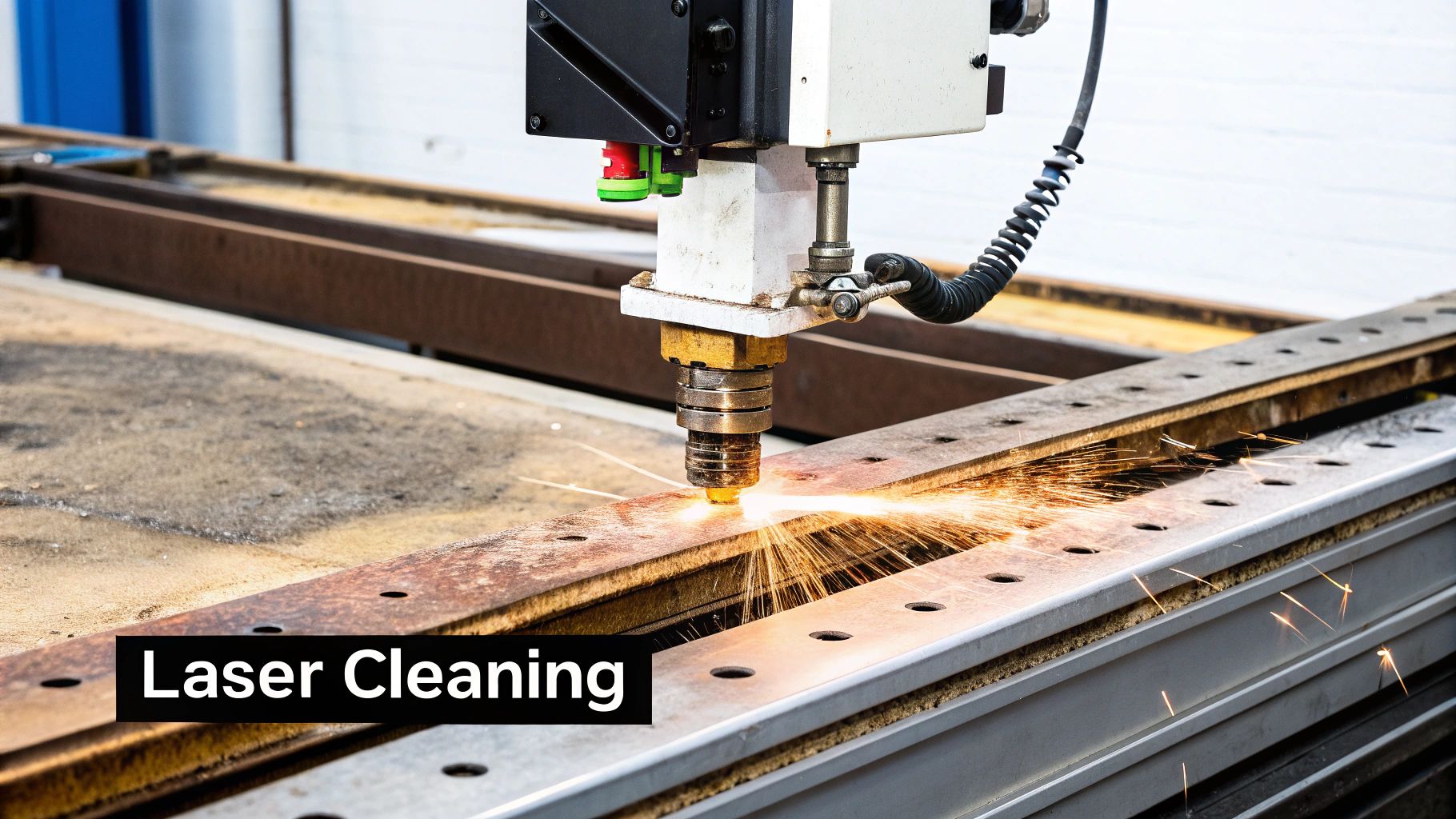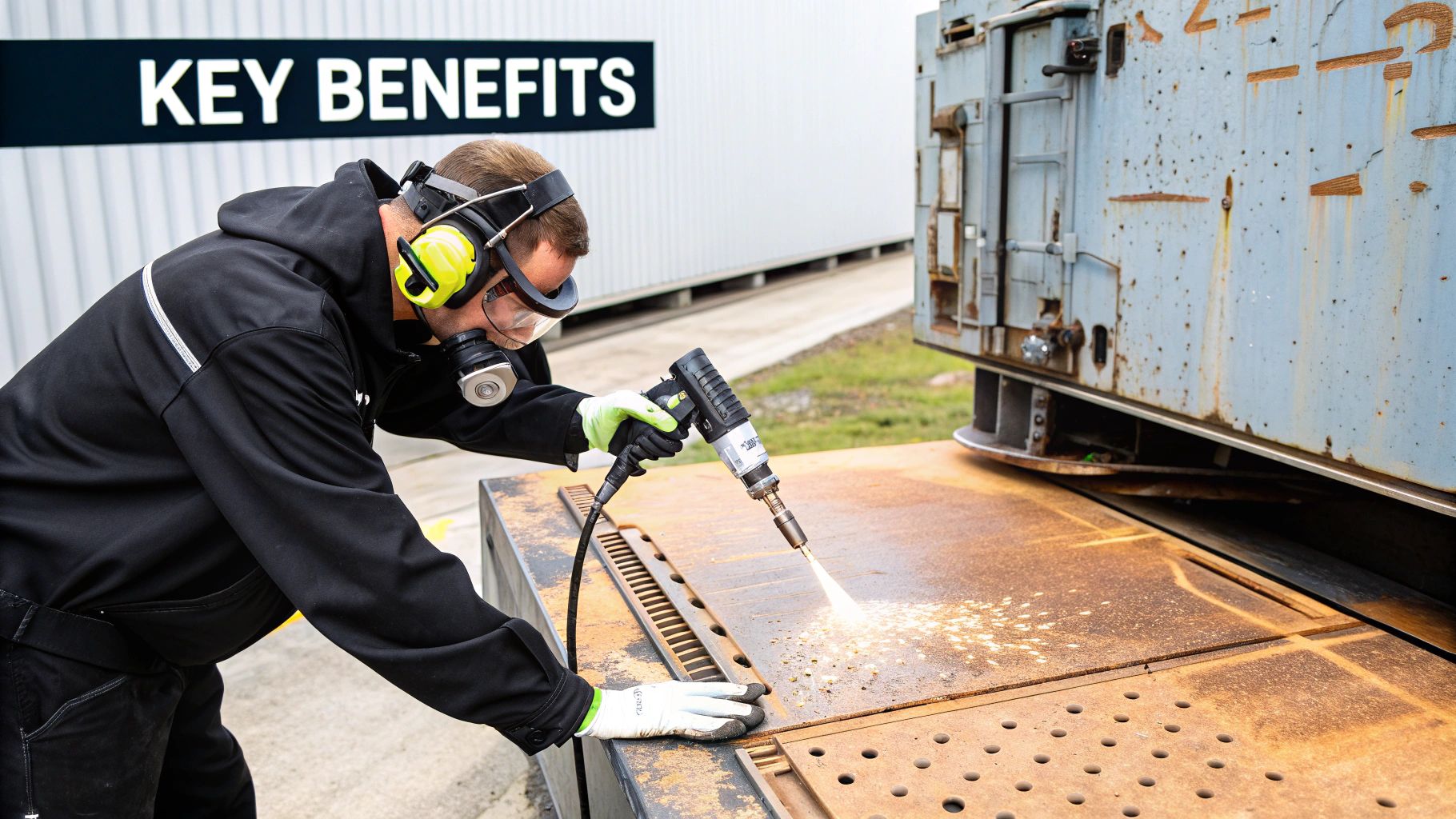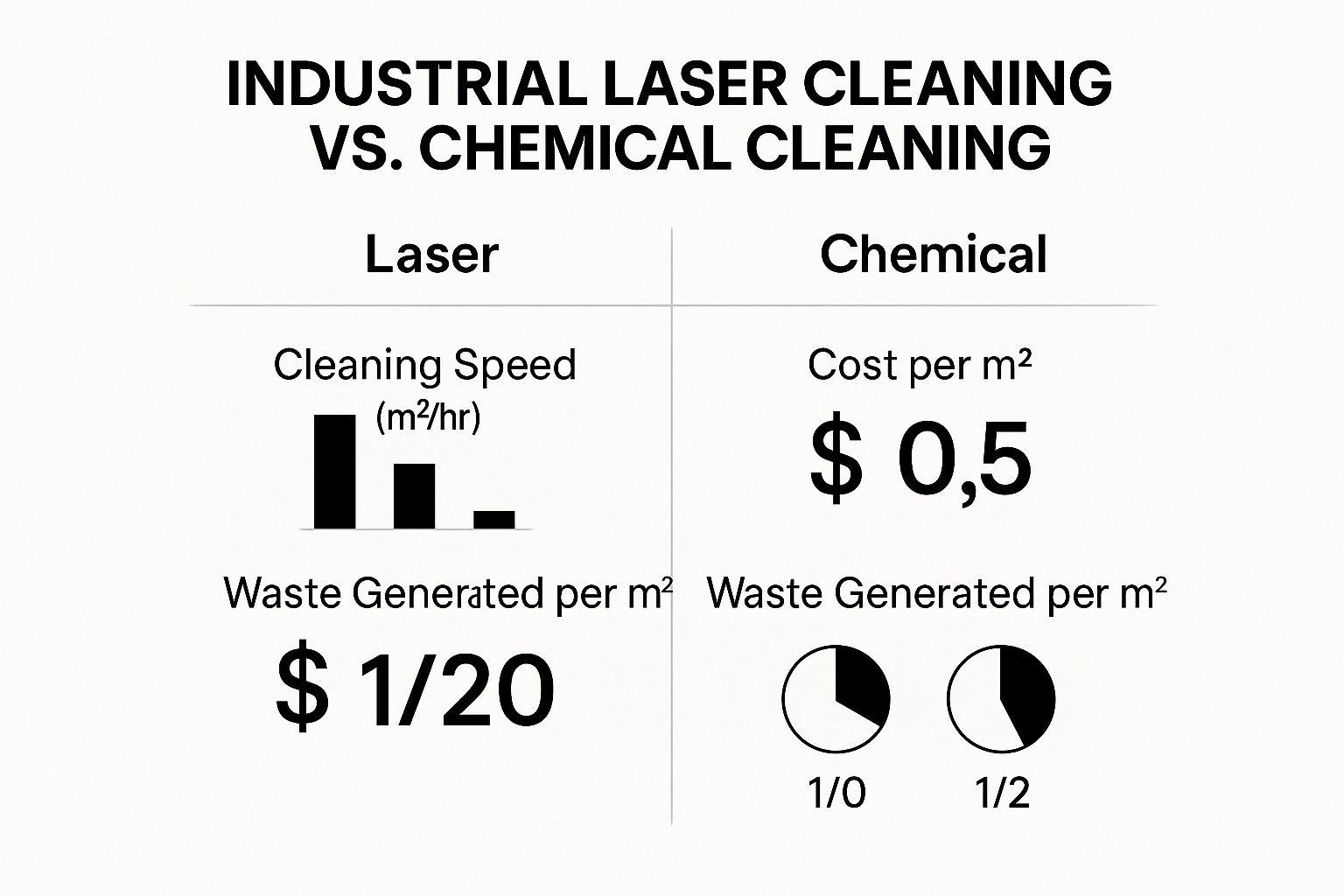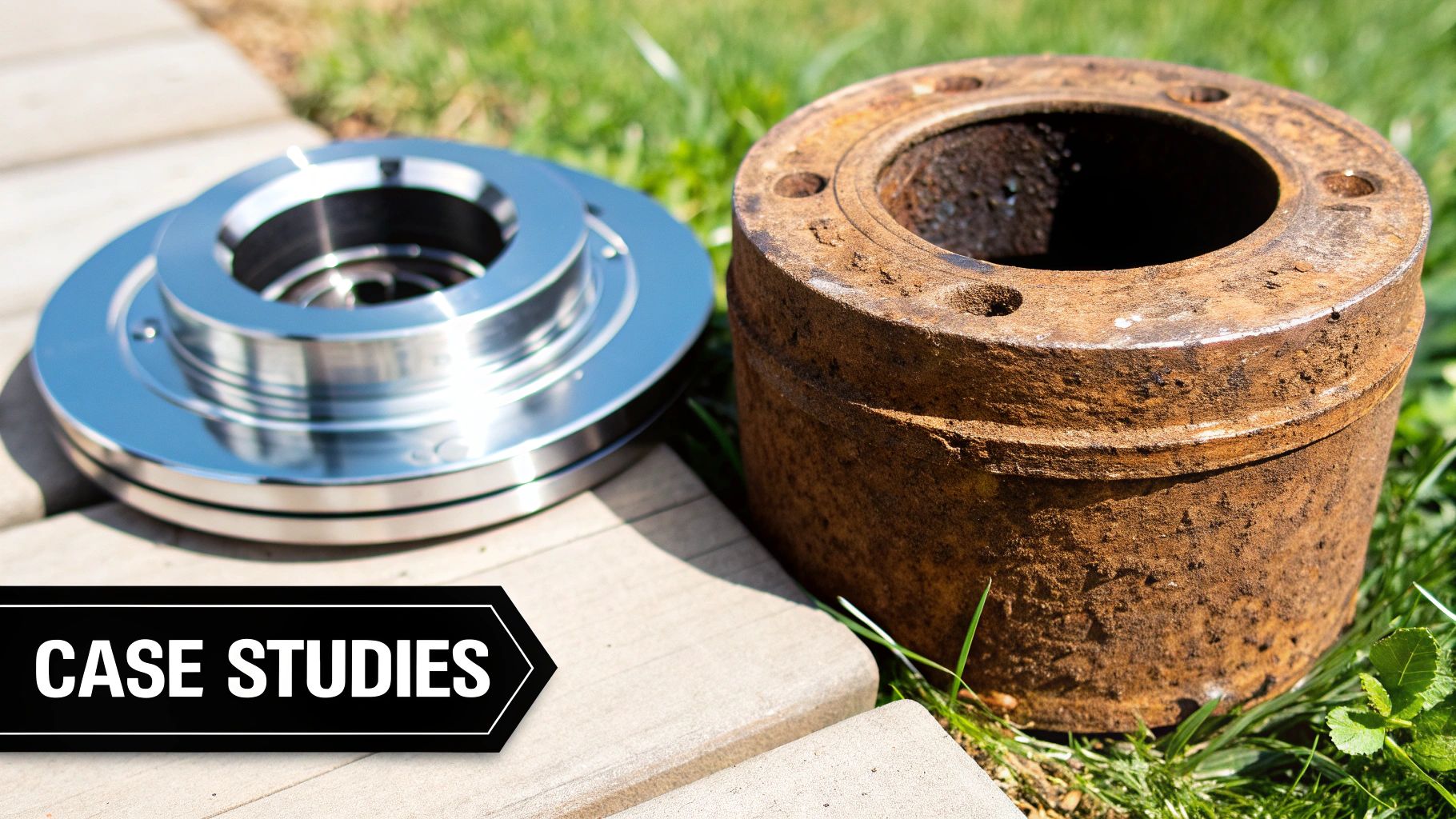Industrial Laser Cleaning: Revolutionize Surface Prep
- Laserverse

- May 12
- 11 min read
The Science Behind Industrial Laser Cleaning

Industrial laser cleaning may sound futuristic, but it's based on established physics principles. This technology uses focused light to remove unwanted surface substances. This isn't ordinary light; it's a highly concentrated laser beam delivered in short, powerful pulses. These pulses interact with contaminants, causing them to evaporate, ablate, or change state for easy removal.
How Laser Light Interacts With Contaminants
The principle of selective absorption is key. The laser's wavelength is chosen to be absorbed by the contaminant, not the underlying material. Rust on steel, for instance, absorbs a specific wavelength much more effectively than the steel itself. This targeted absorption rapidly increases the contaminant's temperature, leading to its removal without harming the base material. It’s like precisely removing weeds without disturbing surrounding plants.
Types of Lasers Used in Industrial Cleaning
Different lasers offer unique advantages. Fiber lasers, YAG lasers, and CO2 lasers are common in industrial cleaning. Fiber lasers are efficient and compact, ideal for robotic systems. YAG lasers offer high power and excellent beam quality for demanding tasks. CO2 lasers are often preferred for organic materials and non-metallic substrates. The right laser depends on the contaminant, substrate material, and desired cleaning speed.
Wavelength and Material Considerations
Choosing the right laser wavelength is crucial. Different materials absorb light at different wavelengths. The correct wavelength ensures the laser energy targets the contaminant, minimizing damage to the base material. This precision allows for micron-level accuracy, surpassing traditional cleaning methods. Companies like TRUMPF and IPG Photonics are leading advancements in laser cleaning. In 2022, HGLASER introduced automated laser cleaning for positive and negative plates, processing 72 products per minute with a 99.5% yield rate. This efficiency is vital for high-volume manufacturing. More statistics can be found here: Laser Cleaning Market Growth Trends. Understanding emerging trends is key to grasping the future of industrial laser cleaning. Learn more about Decision Intelligence AI. As technology advances, industrial laser cleaning will likely become even more precise and efficient, solidifying its place as a leading cleaning technology.
The Business Case for Industrial Laser Cleaning
Beyond its technical capabilities, industrial laser cleaning offers compelling financial advantages. These benefits are shifting this technology from a specialized solution to a core requirement for manufacturers in various industries. This transition is driven by demonstrable returns on investment, often seen within months, not years.
Hidden Costs of Traditional Cleaning
Many businesses underestimate the real cost of traditional cleaning methods. These methods frequently involve substantial expenses for consumables like chemicals and abrasives. Downtime required for cleaning and potential quality problems due to inadequate cleaning further add to the financial burden. For instance, abrasive blasting can harm the underlying material, necessitating rework or even scrapped parts. These hidden costs significantly affect profitability.
Addressing Business Challenges With Laser Cleaning
Industrial laser cleaning helps manufacturers tackle key business challenges. Labor shortages, a pressing concern in areas like California, can be alleviated by the automation capabilities of laser cleaning systems. The technology also assists businesses in meeting increasingly stringent sustainability regulations by minimizing waste and removing the need for harsh chemicals. Laserverse's Netalux systems, for example, provide efficient cleaning with minimal environmental impact. You can explore Our Sitemap to see how Laserverse solutions might benefit your operations.
ROI and Competitive Advantage
The laser cleaning market is experiencing robust growth. In 2023, the global market was valued at USD 0.66 billion and is projected to reach USD 1.15 billion by 2032, a CAGR of 6.36%. You can find more detailed statistics here. This growth, especially strong in North America, is fueled by the efficiency and eco-friendly nature of the technology. Companies investing in industrial laser cleaning are not only enhancing their operational efficiency but also securing a competitive edge.
Strategic Investment for the Future
Forward-thinking businesses in California recognize that industrial laser cleaning is not an expense, but a strategic investment. By reducing operational costs, enhancing product quality, and supporting sustainability initiatives, laser cleaning positions companies for long-term success in a competitive landscape. This technology empowers manufacturers to meet current needs while preparing for future challenges. Embracing industrial laser cleaning is an investment in a cleaner, more efficient, and ultimately, more profitable future.
Industrial Laser Cleaning Across Leading Sectors

Industrial laser cleaning is rapidly changing how various industries operate. From aerospace to heritage conservation, its precision and efficiency are proving highly effective. Let's explore how this cleaning method is being applied across different sectors.
Aerospace: Extending Aircraft Lifespan
Maintaining the structural integrity of aircraft is paramount in the aerospace industry. Industrial laser cleaning is essential for removing coatings, corrosion, and contaminants without harming underlying surfaces. This non-abrasive process extends the lifespan of crucial parts and reduces maintenance downtime, leading to significant cost savings and increased operational efficiency. The enhanced precision also allows for more thorough inspections, ensuring adherence to the highest safety standards.
Automotive: Streamlining Production
The automotive industry constantly strives to optimize production and enhance quality. Industrial laser cleaning offers solutions for both. By removing residues, oils, and contaminants from parts, it streamlines the production process. For example, laser cleaning prepares surfaces for welding or bonding, ensuring optimal adhesion and product integrity, ultimately leading to higher-quality vehicles and faster production cycles.
Electronics: Achieving Unprecedented Cleanliness
Microscopic cleanliness is vital in the electronics industry. Industrial laser cleaning offers the required precision to remove even the smallest particles from sensitive electronic components. This is crucial for ensuring the reliability and performance of devices. Laser cleaning removes oxides and other contaminants from circuit boards and microchips, preventing malfunctions and extending product lifespan.
Medical Devices: Ensuring Patient Safety
Contamination-free surfaces are critical for patient safety in the medical device manufacturing sector. Industrial laser cleaning provides a highly effective sterilization method for medical instruments and implants. It eliminates the need for harsh chemicals, reduces the risk of cross-contamination, and ensures delicate devices remain undamaged during the cleaning process, thus improving patient outcomes and minimizing complications.
Heritage Conservation: Preserving the Past
Heritage conservation requires delicate methods for preserving irreplaceable artifacts. Industrial laser cleaning gently removes dirt, grime, and unwanted coatings from fragile historical objects without causing damage. This precision enables the restoration of artifacts to their original condition, safeguarding our cultural heritage. The ability to selectively remove contaminants makes laser cleaning ideal for intricate details and fragile materials.
Laser cleaning is used widely across industries like manufacturing and art restoration for its ability to remove contaminants without damaging the base material. In areas with a large concentration of high-tech industries, such as California, laser cleaning aligns with environmental regulations by promoting sustainable practices. It offers a cleaner, more efficient alternative to traditional methods, particularly for surface preparation and de-coating. The process's environmental benefits, including reduced chemical use and minimal waste generation, are particularly important in regions with strict environmental regulations like California. More detailed statistics on its environmental impact in California can be found here.
Evaluating Your Application
Several factors should be considered when assessing the suitability of industrial laser cleaning. Material composition, contaminant types, and production requirements are key aspects to evaluate. Consulting with implementation specialists can help determine the feasibility and potential benefits of laser cleaning for your specific application. Careful assessment helps businesses determine if laser cleaning is the right solution for improving quality, increasing efficiency, and reducing environmental impact.
The Environmental Edge of Industrial Laser Cleaning
Industrial laser cleaning isn't just about improved precision and efficiency. It’s also a significant step towards more sustainable manufacturing practices. This technology offers substantial environmental benefits, making it a particularly attractive solution for businesses in California, a region known for its stringent environmental regulations.
Reducing Environmental Impact
Traditional cleaning methods often involve harsh chemicals, consume large quantities of water, and produce hazardous waste. Industrial laser cleaning eliminates or significantly reduces these environmental burdens. By adopting laser technology, companies can minimize their environmental footprint and contribute to a healthier planet. For instance, removing chemical cleaning agents directly translates to less hazardous waste and a safer work environment.
Meeting Regulatory Compliance
Environmental compliance is a critical concern for businesses, particularly in California. Industrial laser cleaning helps companies adhere to increasingly strict regulations. It minimizes waste production, reduces water usage, and eliminates volatile organic compound (VOC) emissions. This allows businesses to proactively maintain compliance, avoiding penalties and fostering a positive environmental image. More information on this topic can be found in our article about Laserverse's blog categories.
Improving Workplace Safety
In addition to environmental benefits, industrial laser cleaning significantly improves workplace safety. Eliminating harsh chemicals removes the risk of chemical exposure for operators. The ergonomic design of many laser cleaning systems also reduces physical strain on workers. This creates a safer, healthier work environment, leading to fewer workplace accidents and improved employee well-being. Laser cleaning is especially beneficial in industries with critical safety standards. You can learn more about the importance of industrial safety and compliance.
Appealing to Eco-Conscious Customers
Consumers are increasingly environmentally conscious and tend to support sustainable businesses. Manufacturers using industrial laser cleaning can highlight their environmental commitment to attract these customers. This can enhance brand image, build customer loyalty, and demonstrate corporate responsibility. Focusing on sustainability isn't just good for the planet—it's also good for business.
Quantifiable Metrics and Real-World Results
The advantages of industrial laser cleaning are demonstrable. Companies switching from traditional methods report measurable reductions in hazardous waste, water consumption, and VOC emissions. These quantifiable improvements provide concrete evidence of the technology’s positive environmental impact. Furthermore, safety managers report notable improvements in workplace conditions, showcasing the tangible benefits for both the environment and employee well-being. These positive results are driving the increasing adoption of industrial laser cleaning across various industries, contributing to a greener future for manufacturing.
Implementing Industrial Laser Cleaning Successfully
Ready to enhance your cleaning processes and make them more environmentally friendly? This guide offers practical steps for implementing industrial laser cleaning, from the initial assessment to ongoing performance evaluation.
Needs Assessment and Application Suitability
A thorough needs assessment is the first step toward successful implementation. This involves identifying your specific cleaning challenges, the types of materials and contaminants you’re working with, and your production volume. For instance, are you removing rust from steel, stripping paint from aluminum, or tackling a different cleaning task? This initial analysis will determine whether laser cleaning is the right solution for your needs. Exploring available laser cleaning solutions can be helpful. Check out Laserverse's product offerings for a better understanding of what’s available.
Equipment Selection Criteria
After determining that laser cleaning suits your requirements, selecting the appropriate equipment is critical. Consider factors like the laser's power (measured in watts), its mobility (handheld vs. automated systems), and its compatibility with your existing automation setup. Laserverse offers a variety of systems, ranging from the compact Netalux Needle for smaller parts to the powerful Netalux Jango for large-scale operations. Choosing the right tool for the job significantly impacts the success of your implementation.
Training and Skill Development
Effective training is crucial for maximizing the advantages of industrial laser cleaning. Operator certification programs ensure personnel understand how to operate the laser equipment safely and efficiently. Skilled operators can fine-tune cleaning parameters for specific materials and contaminants, achieving optimal results while minimizing the risk of damage. Investing in training ultimately improves cleaning quality and boosts productivity.
Integration With Existing Systems
Integrating laser cleaning into your current production systems requires careful planning. Consider the space requirements for the laser equipment, necessary workflow adjustments, and potential bottlenecks. For example, integrating a laser cleaning system into a robotic arm requires ensuring compatibility and optimizing the process flow. Addressing these logistical challenges upfront ensures a smooth transition and minimizes disruptions.
Performance Benchmarks and Measurement
Measuring the effectiveness of your industrial laser cleaning implementation is essential. Monitor key metrics such as cleaning speed (measured in m²/hr), cost per m², and waste generated per m². To help illustrate the advantages of laser cleaning over traditional methods, the table below provides a comparison across several key performance factors.
To understand the key differences between industrial laser cleaning and other cleaning methods, let's examine the following comparison:
Performance Factor | Industrial Laser Cleaning | Chemical Cleaning | Abrasive Blasting | Mechanical Scrubbing |
|---|---|---|---|---|
Cleaning Speed (m²/hr) | High | Moderate | Moderate | Low |
Cost per m² | Low | Moderate | High | Moderate |
Waste Generated per m² | Very Low | High | Moderate | Low |
Surface Damage | Minimal | Potential | High | Moderate |
Environmental Impact | Low | High | Moderate | Low |
Automation Compatibility | High | Moderate | High | Moderate |
The table highlights how industrial laser cleaning offers advantages in terms of speed, cost-effectiveness, and waste reduction. It also underscores the potential for surface damage and environmental impact associated with traditional cleaning methods.
The infographic below further visualizes the significant advantages of laser cleaning over chemical cleaning:

This comparison clearly demonstrates that laser cleaning offers superior cleaning speed, reduced cost per square meter, and significantly less waste generation. This data-driven approach allows for monitoring the return on investment and identifying areas for further optimization. By following these steps, you can successfully implement industrial laser cleaning and reap its numerous benefits.
The Future of Industrial Laser Cleaning Technology

Industrial laser cleaning is already making waves in various sectors. However, its future potential is even more promising. Advancements in laser sources, coupled with integration with other technologies, are set to broaden the capabilities and applications of this cleaning method. These advancements will tackle some current limitations, making industrial laser cleaning more widely accessible.
Advancements in Laser Sources
The core of any laser cleaning system is its laser source. Current research and development focuses on improving these sources for faster processing, broader material compatibility, and greater precision. This will allow manufacturers to clean a wider variety of materials more efficiently and with a lower risk of damage.
For instance, ultrashort pulse lasers offer incredibly precise control, minimizing heat affected zones and allowing for cleaning delicate materials. Improvements in fiber laser technology are also resulting in more compact, powerful, and affordable systems. These enhancements will open doors to new laser cleaning applications and industries.
AI and Machine Learning Integration
Artificial intelligence (AI) and machine learning are playing an increasingly vital role in industrial processes. In laser cleaning, these technologies are enabling the creation of adaptive systems that automatically optimize parameters like laser power and scan speed. This automation improves the quality and consistency of cleaning while reducing the need for specialized operator expertise. This translates to consistently high-quality cleaning results, regardless of the material or contaminant being removed.
Miniaturization and Portability
A fascinating trend in laser cleaning is the move towards miniaturization. Powerful laser systems are becoming smaller and more portable, expanding their use in field applications and situations where larger equipment isn't practical. Handheld laser cleaning devices are growing in popularity, providing flexibility for cleaning complex shapes and hard-to-reach areas. This is especially valuable in industries like aerospace and automotive repair.
Robotic Integration for Complex Geometries
Integrating laser cleaning systems with robotic arms and automated platforms is another significant step forward. This combination allows for the autonomous cleaning of complex shapes and large-scale operations. It also enhances safety by minimizing human interaction with potentially hazardous environments. Robotic laser cleaning offers a more efficient and safer alternative to manual cleaning for intricate parts or large structures.
Addressing Current Limitations
Innovations in industrial laser cleaning technology are tackling some of its current limitations. Increased processing speeds are making laser cleaning more cost-competitive with traditional methods, especially for high-volume jobs. Research is also underway to reduce the initial investment costs of laser cleaning equipment, aiming to make the technology more accessible to smaller businesses. While cost remains a factor, rising demand and technological progress suggest that prices will become more competitive over time.
To better understand the financial implications of implementing industrial laser cleaning, consider the following table:
ROI Analysis for Industrial Laser Cleaning Implementation This data table presents the financial considerations for businesses implementing industrial laser cleaning, including initial costs, operational savings, and projected payback periods based on company size and application type.
Business Size/Type | Initial Investment | Annual Operating Costs | Annual Savings vs. Traditional Methods | Estimated Payback Period | 5-Year ROI |
|---|---|---|---|---|---|
Small Job Shop | $50,000 | $5,000 | $20,000 | 2.5 years | 300% |
Medium Manufacturer | $150,000 | $15,000 | $75,000 | 2 years | 400% |
Large Industrial Facility | $500,000 | $50,000 | $250,000 | 2 years | 400% |
Specialized Automotive Repair | $75,000 | $7,500 | $30,000 | 2.5 years | 300% |
Aerospace Component Cleaning | $250,000 | $25,000 | $100,000 | 2.5 years | 300% |
The table illustrates that while initial investments can vary, the potential annual savings and return on investment are substantial across different business sizes and application types. The estimated payback periods are generally short, indicating a rapid return on investment for businesses adopting laser cleaning technologies.
Ready to explore how Laserverse can transform your cleaning processes? Visit Laserverse today to learn more about our laser cleaning solutions.